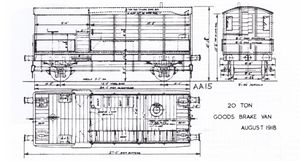GWR Coaching Stock and Wagon Diagrams
GWR Diagram codes were introduced by George Jackson Churchward to allow easy reference to different types of coaching stock. The Diagram Code for each type consisted of one or two letters which represented the general category, and a number which denoted particular design of that type, such as A28 or DD3.[1]. The Diagram Index for wagons was first prepared circa 1905, followed by a similar index for carriages around 1910.[2]
The numbering schemes used for coaching stock and wagons ran in parallel, so the same codes appeared in both. Thus on the SVR, Siphon G 1257 was built to Coaching Stock diagram O11 while 5-plank Open Wagon 13154 was built to Wagon diagram O11. The GWR Diagram Book which listed the diagrams typically allocated a page for each diagram which showed its major dimensions and characteristics.
Coaches and Wagons (and also locomotives and tenders) were generally built in batches known as Lots, with each lot number being allocated in sequence when ordered. The four groups of Lot numbers also ran in parallel. Some designs which pre-dated the introduction of Diagram Codes were never allocated Diagram codes even if construction continued after that time and were identified by their 'old series' Lot number. SVR examples include GWR 41277 of 1890.
Other railway companies used broadly similar systems of Diagrams and Lots, although using different combinations of letters and numbers.
Contents
Coaching stock diagrams
The table below shows the letters allocated to each category and the examples currently resident on the SVR.
| Diagram | Description | SVR Examples | Notes |
|---|---|---|---|
| A | Bogie first class | 178, 238 | |
| B | Bogie second class | ||
| C | Bogie third class | 829, 1086, 1087, 1116, 1146, 2119, 2426, 3930, 4786 | |
| D | Bogie brake third | 650, 2233, 2242 5804, 5883 | |
| E | Bogie composite and Brake composite | 6045, 6562, 6913, 7284 | |
| F | Slip coach | ||
| G | Saloon | 9055, 9103, 9369 | |
| H | Catering vehicle | 9581, 9615, 9627, 9653, 9654 | |
| J | Sleeping car | 9084, 9085 | |
| K | Passenger brake van | 98, 261, 1145 | |
| L | Mail van | ||
| M | Bogie parcels van (and similar) | ||
| N | Horse box | ||
| O | Milk van / tank | 1257, 1399, 2926 | |
| P | Carriage truck | ||
| Q | Inspection saloon | 80969, 80972 | |
| R | 4-wheeled first class | ||
| S | 4-wheeled third class | ||
| T | 4-wheeled brake third | ||
| U | 4-wheeled composite / brake composite | ||
| V | 4-wheeled brake van | ||
| W | Parcels and Miscellaneous van |
Wagon diagrams
The table below shows the letters allocated to each category and the examples currently resident on the SVR.
| Diagram | Description | SVR Examples | Notes |
|---|---|---|---|
| A | Girder Wagons | Articulated wagons for boilers, guns, bridge girders etc. | |
| B | Armour plate and roll wagons | ||
| C | Boiler trucks and trolleys | ||
| D | Plate glass wagons | ||
| E | Wheel and propeller wagons | ||
| F | Steam roller trucks | ||
| G | Road vehicles | 41990, 42138, 42272, 42343, 65801 | Flat and well wagons to carry large road vehicles, covered trucks for motor cars etc. |
| H | Flat wagons | 39860 | |
| J | Rail and timber wagons | 60841, 107291 | |
| K | Crane testing wagons | ||
| L | Match trucks | Where built for that purpose. Often adapted from other Diagrams, such as 2501 | |
| M | Shunters trucks | 41736 | |
| N | Coal and mineral wagons | 83831 | |
| O | Open merchandise wagons | 2504, 13154, 25190, 94059, 97398, 98480, 99965, 102691, 108085, 2501* | *Now used as a match truck |
| P | Ballast and sand wagons | 30903, 40841, 60562, 60906, 80225, 80603, 80684 | |
| Q | Provender wagons | ||
| R | Manure wagons | ||
| S | Fish wagons | ||
| T | Permanent way wagons | 14428, 40554 | |
| U | Stone wagons | ||
| V | Covered goods vans | 58725, 65620, 82554, 93016, 93045, 95353, 101961, 103592, 104621, 112889 | |
| W | Cattle trucks | ||
| X | Meat vans | 105873 | |
| Y | Fruit vans | 2303, 2424, 2815, 3429, 3467, 134290 | 92080 and 92090 were built in 1958 to BR Diagram 805 |
| Z | Gunpowder vans | 'Improvised' gunpowder vans are under Diagram V | |
| AA | Brake vans | 17410, 40362, 68501 | |
| BB | Stores vans | ||
| CC | Tool and workshop vans | 14984, 80982 | |
| DD | Tank wagons | 43989, 80990 | |
| EE | Flat wagons for tanks | ||
| FF | Trestle plate wagons |
See also
References
- ↑ Wikipedia
- ↑ Atkins, Beard & Tourret (2013) pp. 490-494.
Links
- Great Western Railway wagons: Diagram codes on Wikipedia
- Coaches of the Great Western Railway: Diagram codes on Wikipedia
